Steel monsters: UK super heavy tanks
TOG Tanks
The super heavy TOG II tank was developed from 1940 to 1944 year, that is, almost throughout the Second World War. The only copy of this unusual combat vehicle, which is stored in the Bovington tank museum, has survived to this day. The tank received the designation TOG (The Old Gang - the old gang), thanks to the fact that Albert Stern, a legend legend in the British tank building industry, worked on it. Previously, he served as secretary of the First Land Ship Committee in the world, thanks in large part to his work and will in the UK in 1916, and the world's first serial production of tanks was established. In 1939, Stern gathered around him prominent like-minded people who were at the origin of the creation of the first English tanks. He managed to enlist the support of the Cabinet of Ministers and form the Committee for the Creation of a Special Machine (SVDC). Given the assembled team of tank building veterans, this committee was nicknamed The Old Gang. The main trouble Stern was his high self-esteem, he believed that one knows how to create a new successful tank. Together with his illustrious like-minded people, among whom were William Tritton, Sir Ernst Swinton, Sir Eustace Tennyson and others, he began to create a tank that was initially late for his war.
The direct work on the TOG tank began in February 1940, when a wooden mock-up was made and orders were sent to some of the components of the future tank. Already at first glance, the appearance of the car hit its archaic. It was a tall, narrow and long combat vehicle that was a priori sluggish. In fact, she repeated the design of the first tanks. The archaism was intensified by the choice of the diamond-shaped case, by machine-gun sponsons on the sides and by tracks from nickel steel of the First World War. However, the machine gun sponsons disappeared already at the prototype stage, but did not become a more modern tank from such a step. Initially, the designers decided to install an 75-mm howitzer in the front hull, but over time they decided to install a tower of circular rotation. According to the first requirements, the tank's armor was supposed to withstand hits of 47-mm armor-piercing shells, but in the future its thickness was increased all the time. On the prototype, onboard booking reached the 65 mm. Field tests of the first version of the tank took place on September 27 1940. The weight of the tank, according to various sources, was from 65 to 71 tons, and the speed it developed did not exceed 13,67 km / h.
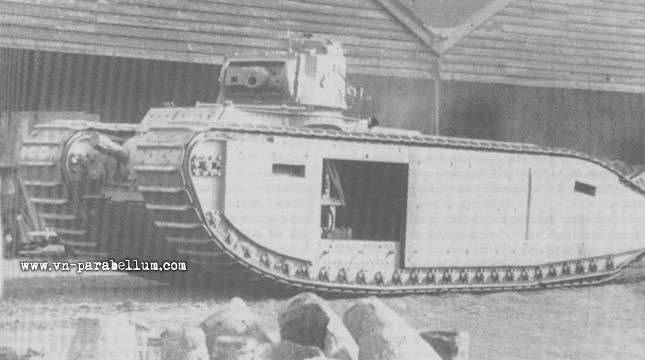
After the lightning triumph that the German tank units demonstrated in France in May-June 1940, the whole archaic and almost complete uselessness of the TOG tank manifested itself even more. The era of mobile and highly mobile tanks entered the stage, while the TOG could not answer the demands of its time. In an amicable way, all the work on this project had to be curtailed, but in fact the work on the machine, which was outdated at the project stage, continued. During the tests, it was quickly established, although it was initially clear that the combat vehicle was completely non-maneuverable due to the fact that it had a narrow long body, but nothing could be done with this because of the tank design chosen. The drawbacks were further aggravated by the fact that, as in the first British tanks, the TOG I simply did not have a spring-loaded suspension - small support rollers were simply rigidly fixed to the body.
The second problem was the electromechanical transmission. On the TOG, the engine rotated an electric generator that served to power two onboard engines. The steering wheel of the tank control was connected with a potentiometer that varied the voltage on the onboard electric motors. The rotation of the tank was made due to the difference in the speed of rotation of the tracks. During operation, the electric motors are constantly overheated. During the 28 test in May 1941, the tank had to constantly make stops so that they could cool down.
Despite all the problems, in parallel, work was carried out on the tank TOG II, the order for which was issued 6 on May 1940. The model was built in a single copy and, most likely, was intended solely for the installation of a larger tower, which would accommodate 57-mm gun. At the first tests on the tank was a wooden tower with a fake gun. The real tower was designed for installation on the TOG II R tank (Revised - corrected), which differed less by 6 feet in length and the torsion bar suspension of the road wheels. However, TOG II R was never built in metal, and the tower made for it was installed instead of a wooden model on TOG II.
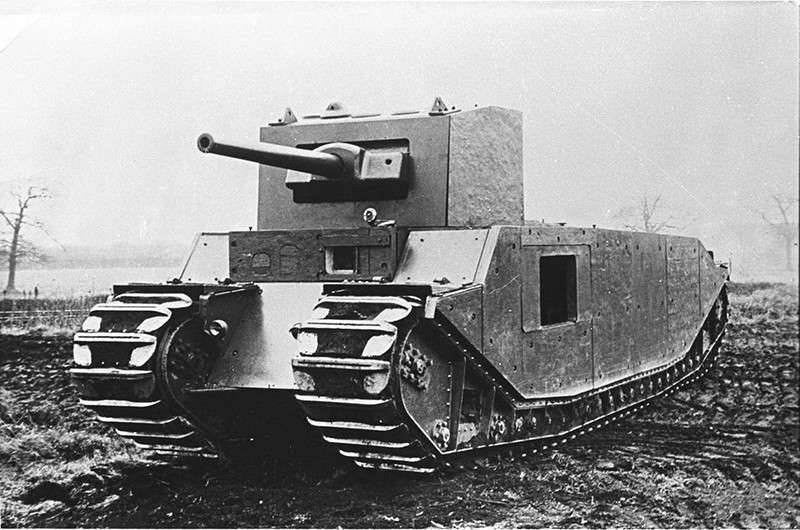
Perhaps the main difference between the TOG II was a torsion bar suspension, a tower in which the 3 inch gun QF 3 inch 20 cwt anti-aircraft, converted from an anti-aircraft gun, and another undercarriage structure finally appeared. The hull was altered in such a way that the caterpillar branch, passing the rear wheel, descended into a special tunnel through which it went forward, and at the exit of it rose, in order to get to the front sloth. The solution with the tunnel was used to expand the hull of the tank to install the shoulder strap of a larger turret, which received more powerful weapons.
By 1943, the tank decided to arm the 17-pound cannon in the turret, which was created by Messrs Stothert and Pit. Later this tower appeared on the tank A30 Challenger. In the same year, in May, on tests, the car behaved flawlessly, but the military wisely refused to accept this monster. Finally this story with "Tog" ended only in 1944 year. The fact that this epic attempt to create a tank, originally from World War I after 20 years after its completion lasted so long, speaks not only about personal stubbornness and the collapse of hopes of Arthur Stern and his Old Gang, but also that in order to develop and produce the tracked fighting vehicles that are really needed for the country, a large number of engineers were engaged, practically speaking all nonsense, for almost the entire war. Work on the TOG tanks were a clear demonstration of the fact that during the years of World War II, the British tank building industry was in a disastrous situation.
Performance characteristics of TOG II:
Overall dimensions: length - 10 130 mm, width - 3120 mm, height - 3050 mm.
Combat weight - more than 81 t.
Armament - the gun OQF 17pdr caliber 76,2 mm and BESA machine gun caliber 7,92 mm;
Reservations - forehead and hull sides - 62 mm, roof - 25 mm, bottom - 12 mm, front tower - 63 mm.
The power plant - 12-cylinder diesel engine Packsman-Ricardo 12TP, hp power 600
Maximum speed - 13,67 km / h.
Power reserve - 112 km (on the highway).
Crew - 6 man.
A39 Tortoise
The heavy assault tank A39 Tortoise was supposed to be Matilda II of a qualitatively new level, but he too was late for the war. Despite this, the car managed to be built in metal, from 1945 to 1947, it was possible to build 6 prototypes, one of which was saved and maintained on the go. In fact, the "Turtle" was never a tank, by all indications it was an ACS, since the A39 lacked a tower, and the gun was located directly in the fighting room. But according to the English classification, ACS could not be so heavy (the weight of the A39 Tortoise exceeded 79 tons), therefore it was classified as a heavy assault tank. By weight, this machine came close to super-heavy tanks or super-heavy SPGs.
At the beginning of 1943, Britain had already ceased to doubt the defeat of Germany. Therefore, the military is increasingly thinking about the problem of overcoming the long-term lines of defense of the enemy. Their fear was caused by the Siegfried Line. And although the experience of previous battles demonstrated that the time of the Maginot lines had sunk into oblivion, certain fears among the British military still remained. They believed that the German West Wall was saturated with anti-tank ditches, concrete pillboxes and other fortifications. For this reason, the ground forces need a tank that could be under the enemy’s anti-tank weapons for a long time, simultaneously hitting its firing points. During the development of the final version of the tank with the symbolic name “Tortoise”, the project underwent a huge amount of processing, leaving behind a whole line of machines from AT-1, AT-2, AT-3 up to AT-18.
The undercarriage of the tank, for which the A39 index was eventually attached, was quite original. On each side there were 8 dual support rollers, which were blocked between themselves in pairs in the 4 trolley, there were also 6 supporting rollers. In fact, due to the huge mass of the combat vehicle approaching 80 tons, the carts were a rigid structure with 4 separate support rollers, two of which were mounted on a common axis. In addition, it was constructively possible to dismantle the outer pair of rollers in order to facilitate the process of transporting the tank and reduce the lateral load on the trolley. The suspension of the assault tank A39 Tortoise was torsion. An unusual solution for tank building in Britain was the front arrangement of drive wheels with ridge gearing. The guide wheels (spoke) were at the back. In order to at least somehow compensate for the high specific pressure on the ground, the tank used wide crawler tracks - 813 mm with a centering ridge.
In the bow of the A39 tank, in front of the control compartment, there was a transmission that included a Merrit-Brown H51D manual gearbox. This box through the separate reverse provided the driver 6 speeds forward and backward and had onboard brakes to control the machine on the course. In the engine compartment, which corresponded to the width of the hull superstructure, a sufficiently powerful petrol 12-cylinder Rolls-Royce Mk.V “Meteor” gas-powered aspirated engine was mounted, which was included in the circuit of the liquid cooling system. There was a radiator in front of the engine, and on either side of it, the designers placed two fuel tanks of different sizes - 245 liters to the left and 390 liters to the right.
The armament layout approved by the project and the impressive dimensions of the gun required the use of a conning tower or superstructure on the most traditional design. On the sides it hung over the chassis of the assault tank. In any other form, it was impossible to provide more or less comfortable work of the crew members. The “heaviest” for release was the front part of the hull superstructure, the booking thickness of which reached 228 mm. The lower frontal part of the hull, the rear section and the roof of the superstructure were separate castings that were welded separately. Due to the overall uniqueness of the combat vehicle, the layout of the combat compartment looked quite original. The crew of this mastodon reached the 7 man: tank commander, driver, gunner, two loaders, frontal machine gunner and upper turret gunner.
The main weapon of the Turtle was the anti-tank 37-pounder gun (94-mm), which was located almost in the center of the frontal part of the superstructure. On the horizon, the gun was aimed at 20 degrees in both directions. The gun was an adaptation of the anti-aircraft 3,75-inch artillery system for new needs. The British repeated the same trick as the Germans with their famous 88-mm anti-aircraft gun. In the process of adaptation, the British worked with the recoil devices, the new barrel, the aiming system, but the main innovation was the separate-cartridge loading. During the tests, the speed of an armor-piercing projectile fired from this 94-mm gun was 880 m / s, which was better than the 3,75-inch anti-aircraft gun, but worse than the German 88-mm tank guns. However, the results shown on the tests completely satisfied the representatives of the British army.
Auxiliary weapons were three machine gun caliber 7,92-mm. One of them was embedded in a ball mount to the left of the gun, its declination angles were 35 degrees. Spark of exactly the same BESA machine guns with angles of vertical guidance from + 15 to -10 °, was located in a special machine-gun turret located on the roof of the combat vehicle from the right to the rear. To the left of the machine gun turret there was a commander turret of circular rotation with a binocular periscope, which was movable in a vertical plane and with a viewing device. Binocular periscope through repeaters was connected with the gunner’s gun sight and the upper arrow. The additional armament of the heavy assault tank was smoke grenade launchers, which proved to be excellent on the battlefields of the Second World War.
While the first prototype of the combat vehicle was being assembled, the war simply ended. In general, the need for a heavy assault tank disappeared in the fall of 1944, when it became clear that the fortifications of the Siegfried Line are not as terrible as previously thought. Against the background of contemporary tanks - the Soviet EC-3 or the German Royal Tiger, which was considered promising, А39 looked, to put it mildly, old-fashioned. Therefore, already in 1946, the British reduced the order to 12 tanks at the price of 141 666 pounds per car. But this contract was later cut to 6 units. In total, 1947 kits for the assembly of "Turtles" were released by 6, five of them turned into full-fledged tanks, and the sixth was used as a set of spare parts for them.
A39 Tortoise performance characteristics:
Overall dimensions: length - 10060 mm (with a tool), width - 3900 mm, height - 3050 mm.
Combat weight - 79 tons.
Armament - 94-mm gun QF 32 pounder and 3х7,92-mm Besa machine gun.
Reservations - body front - up to 228 mm, forehead felling - up to 228 mm, body side - 178 mm, side cabin - 228 mm, roof - 33 mm.
The power plant is a 12-cylinder petrol Rolls-Royce Mk.V "Meteor" hp 600.
Maximum speed - 19 km / h (on the highway), 6 km / h (country road)
Power reserve - 140 km (on the highway).
Crew - 7 man.
Information sources:
http://www.vn-parabellum.com/gb/tog-art.html
http://www.tank2.ru/country/england/heavienglish/TOG
http://www.aviarmor.net/tww2/tanks/gb/heavy_a39.htm
http://alternathistory.com/tyazhelyi-shturmovoi-tank-39-tortoise-velikobritaniya
http://warspot.ru/1223-sverhtyazhyolye-tanki-stalnye-velikany
Open source materials
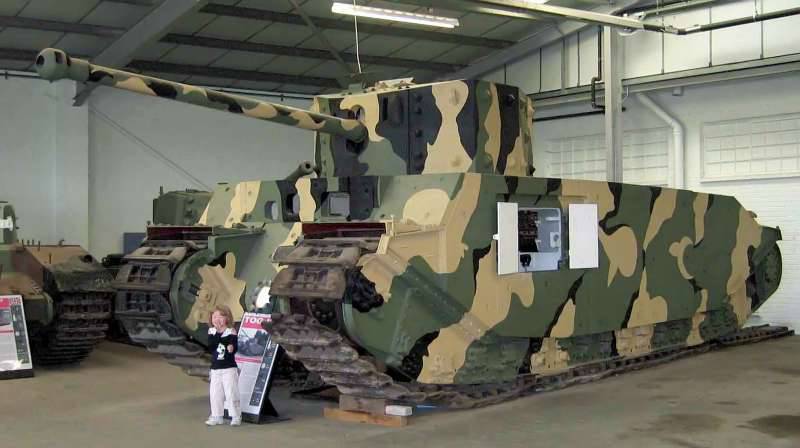
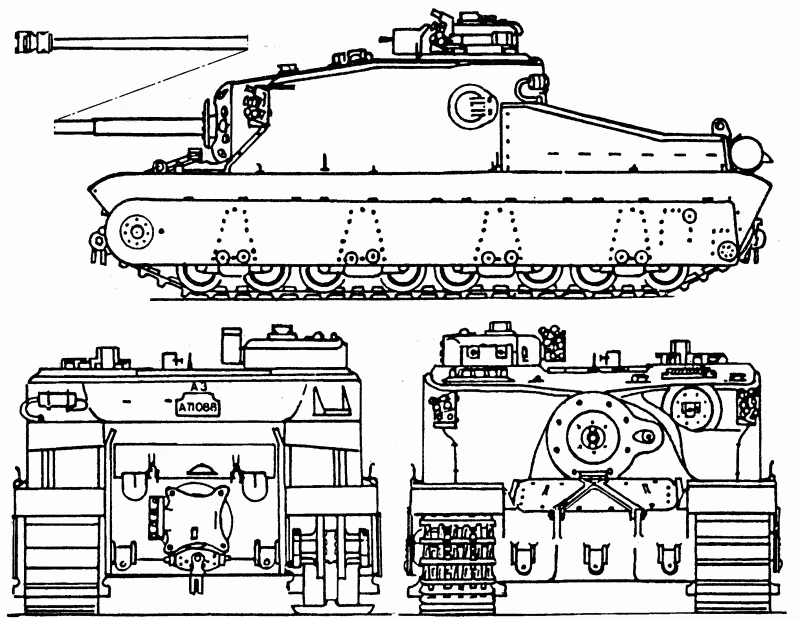
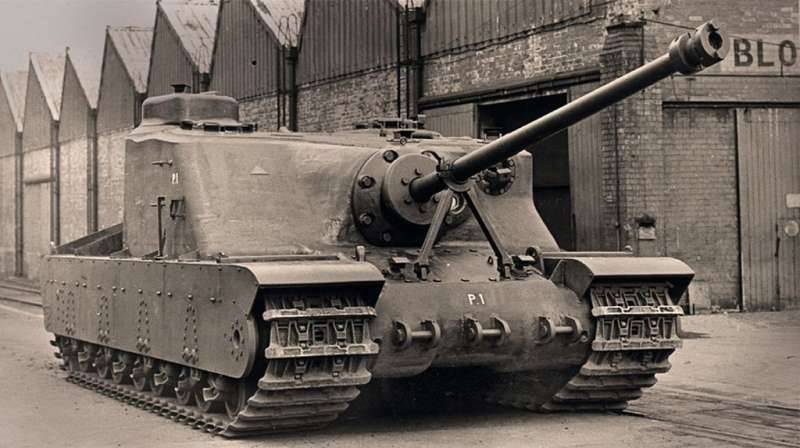
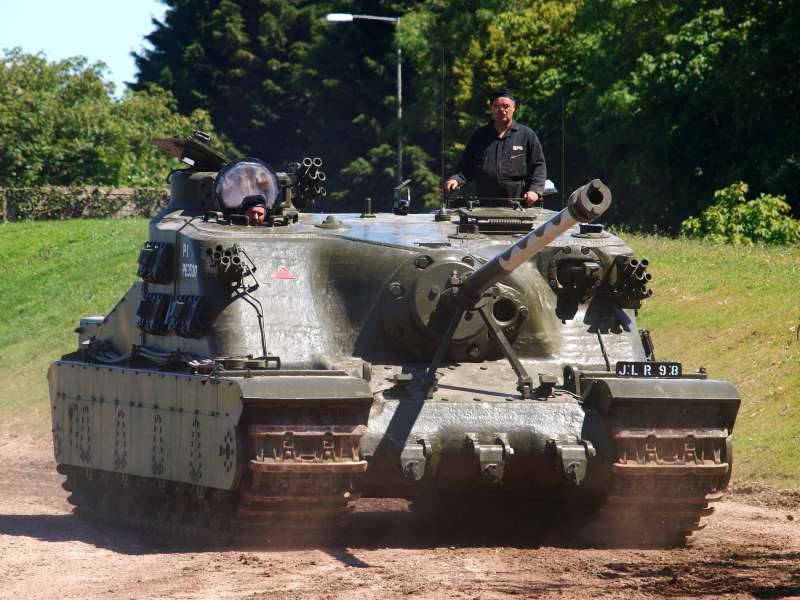
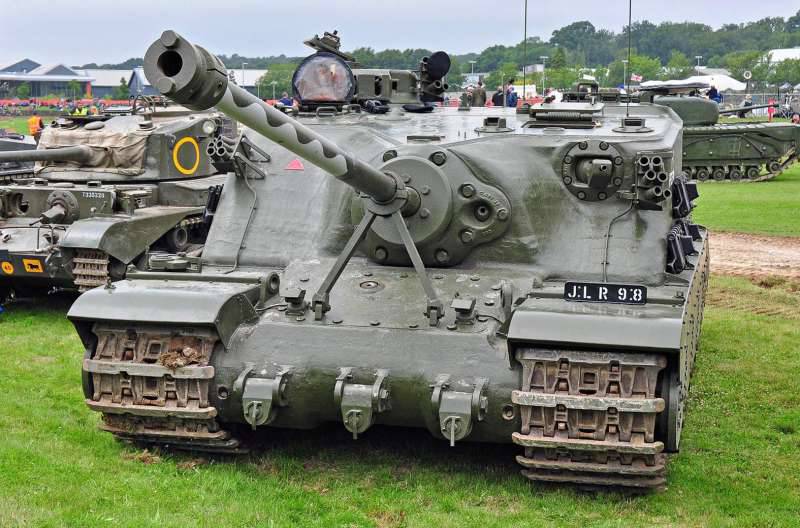
Information